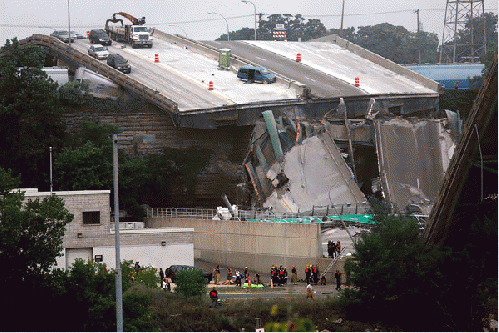In a landmark infrastructure bill passed in December, Congress finally penetrated the Fed's "independence" by tapping its reserves and bank dividends for infrastructure funding.
The bill was a start. But some experts, including Congressional candidate Tim Canova, say Congress should go further and authorize funds to be issued for infrastructure directly.
For at least a decade, think tanks, commissions and other stakeholders have fought to get Congress to address the staggering backlog of maintenance, upkeep and improvements required to bring the nation's infrastructure into the 21st century. Countries with less in the way of assets have overtaken the US in innovation and efficiency, while our dysfunctional Congress has battled endlessly over the fiscal cliff, tax reform, entitlement reform, and deficit reduction.
Both houses and both political parties agree that something must be done, but they have been unable to agree on where to find the funds. Republicans aren't willing to raise taxes on the rich, and Democrats aren't willing to cut social services for the poor.
In December 2015, however, a compromise was finally reached. On December 4, the last day the Department of Transportation was authorized to cut checks for highway and transit projects, President Obama signed a 1,300-page $305-billion transportation infrastructure bill that renewed existing highway and transit programs. According to America's civil engineers, the sum was not nearly enough for all the work that needs to be done. But the bill was nevertheless considered a landmark achievement, because Congress has not been able to agree on how to fund a long-term highway and transit bill since 2005.
That was one of its landmark achievements. Less publicized was where Congress would get the money: largely from the Federal Reserve and Wall Street megabanks. The deal was summarized in a December 1st Bloomberg article titled "Highway Bill Compromise Would Take Money from US Banks":
The highway measure would be financed in part by a one-time use of Federal Reserve surplus funds and by a reduction in the 6 percent dividend that national banks receive from the Fed. . . . Banks with $10 billion or less in assets would be exempt from the cut.
The Fed's surplus capital comes from the 12 reserve banks. The highway bill would allow for a one-time draw of $19 billion from the surplus, which totaled $29.3 billion as of Nov. 25. . . .
Banks vigorously fought the dividend cut, which was estimated to generate about $17 billion over 10 years for the highway trust fund.
According to Zachary Warmbrodt, writing in Politico in November, the Fed registered "strong concerns about using the resources of the Federal Reserve to finance fiscal spending." But former Federal Reserve Chairman Ben Bernanke, who is now at the Brookings Institute, acknowledged in a blog post that the Fed could operate with little or no capital. His objection was that it is "not good optics or good precedent" to raid an independent central bank. It doesn't look good.
Rep. Peter DeFazio (D-Oregon), ranking member on the House Transportation Committee, retorted, "For the Federal Reserve to be saying this impinges upon their integrity, etc., etc. -- you know, it's absurd. This is a body that creates money out of nothing."
DeFazio also said, "[I]f the Fed can bail out the banks and give them preferred interest rates, they can do something for the greater economy and for average Americans. So it was their time to help out a little bit."
An Idea Whose Time Has Come
It may be their time indeed. For over a century, populists and money reformers have petitioned Congress to solve its funding problems by exercising the sovereign power of government to issue money directly, through either the Federal Reserve or the Treasury.
In the 1860s, Abraham Lincoln issued debt-free US Notes or "greenbacks" to finance much of the Civil War, as well as the transcontinental railroad and the land-grant college system. In the 1890s, populists attempted unsuccessfully to revive this form of infrastructure funding. In the Great Depression, Congress authorized the issuance of several billion dollars of US Notes in the Thomas Amendment to the 1933 Agricultural Adjustment Act. In 1999, Illinois Rep. Ray LaHood introduced the State and Local Government Economic Empowerment Act (H. R. 1452), which would have authorized the US Treasury to issue interest-free loans of US Notes to state and local governments for infrastructure investment.
(Note: You can view every article as one long page if you sign up as an Advocate Member, or higher).






